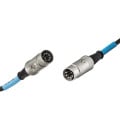- Opis
-
Szczegóły
Piękny i mocny. Twój monologue!Najnowsza generacja analogowych syntezatorów w pięciu żywych kolorachW pełni programowalny syntezator analogowy dla każdego! Monologue to kolejna generacja analogowych syntezatorów, która korzystając z rozwiązań technologicznych większego brata – minilogue – dostarcza innych, nowych brzmień.KORG monologue to 25 klawiszowy w pełni programowalny monofoniczny syntezator analogowy. Smukła, zwarta konstrukcja, „analogowy” workflow oparty na pokrętłach i przełącznikach i unikalne brzmienie, czynią z monologa idealne narzędzie dla wszystkich muzyków. W tak przystępnej cenie nie było dotąd instrumentu analogowego, który oferuje tak wielkie możliwości. Monologue posiada zupełnie nowy filtr, sekcję modulacji, drive i LFO generujące potężne basy i ostre leady. Monologue dysponuje także rozwiniętym step sequencerem, który umożliwia intuicyjną i kompleksową edycję.Analogowy syntezator z nowymi monofonicznymi brzmieniami i sekwencjamiW pełni programowalny – 100 presetów (80 presetów fabrycznych)16-sto krokowy sequencer z technologią zapisu ruchu kontrolerówFunkcja mikrostrojenia pozwa;a na dowolne tworzenie skal muzycznychOscyloskop wizualizuje kształ fali w czasie rzeczywistymZasilanie bateriami, lub opcjonalnym zasilaczemWytrzymały i stylowy aluminowy panel głównyPokrętła pokryte gumą, boki z naturalnego drewnaZłącza MIDI, USB MIDI i Audio Sync do połączeń z innymi urządzeniami (np. minilogue, SQ1, volca, electribe i innymi).Pięć wersji kolorystycznychGwarancja 2 lata - Dostawa
-
Szczegóły dostawy produktu KORG monologue - monofoniczny syntezator analogowy
Wysyłka z Warszawa, Polska.
Dostawa do
Jeżeli chcesz zobaczyć dokładne metody dostawy dostępne w Twojej lokalizacji, uzupełnij powyższe pola.
- Zadaj pytanie
-
Zadaj pytanie odnośnie produktu
- Recenzje (0)
-
0.0
0 recenzji
Oceń ten produkt jako pierwszy
O producencie Korg

KORG jest japońską firmą założoną w 1963 roku przez przez Tsutomu Katoha i Tadashiego Osanai. Aktualnie marka w swojej ofercie ma produkty takie jak np. syntezatory, klawiatury, miksery i narzędzia produkcyjne, bębny i instrumenty perkusyjne, cyfrowe pianina i rejestratory, efekty, tunery, wzmacniacze, głośniki, oprogramowania. KORG tworzy intrumenty wysokiej jakości, które są przystępne cenowo.
Firma
- Siedziba producenta: Japonia
- Średnia ocena produktów: 5.0
Produkty
- Liczba produktów: 201
Statystyki napraw



















